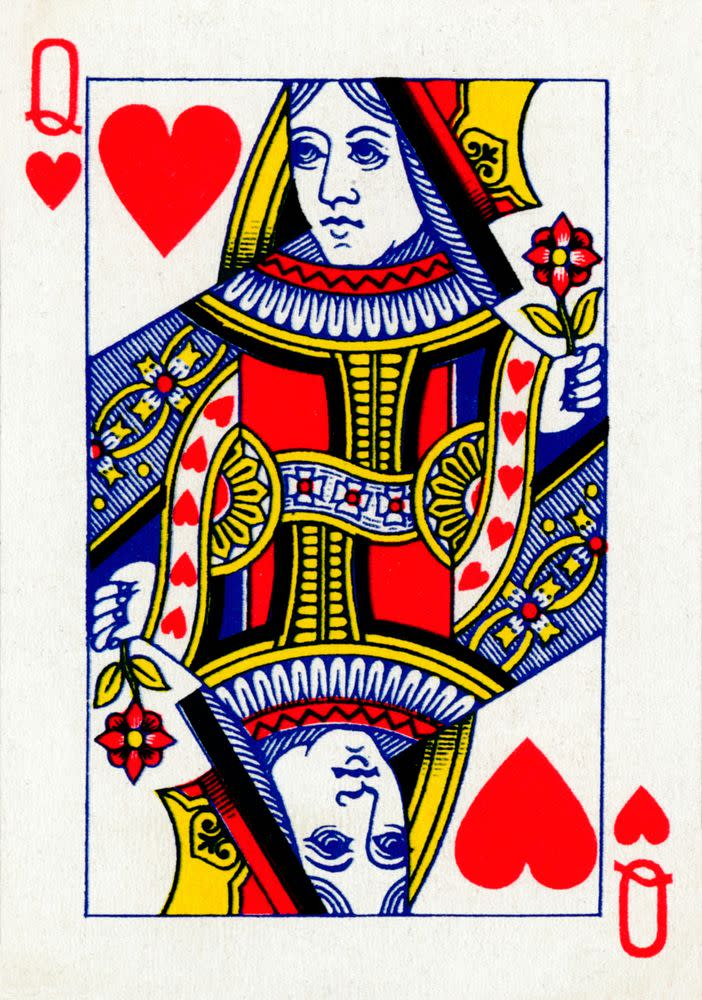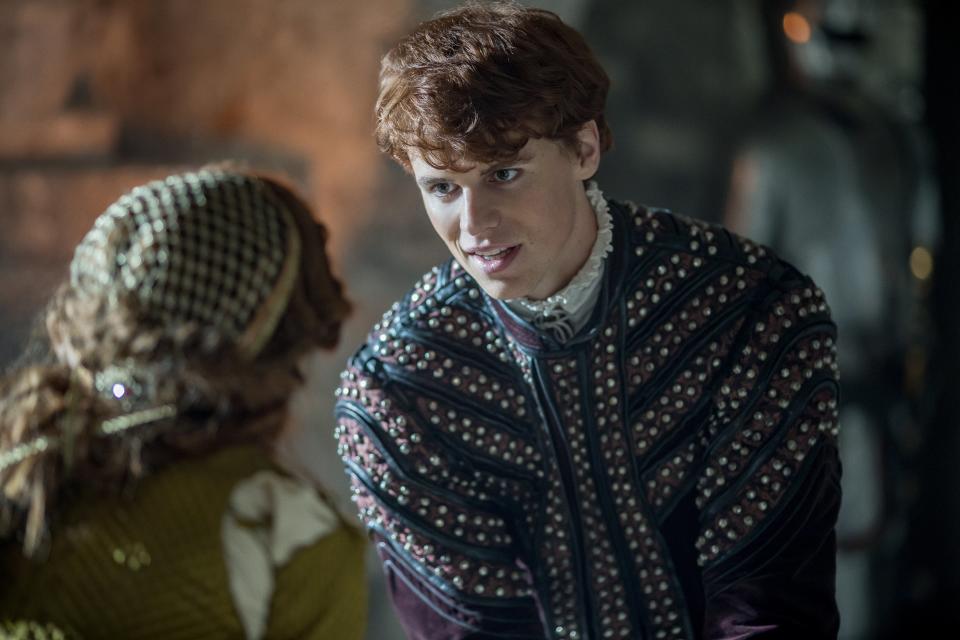The Spanish Princess : Henry VIII gets his flirt on and four more historical observations
The plot thickens on this week’s The Spanish Princess. Determined to fulfill God’s destiny for herself, Catherine begins to spread her assertion that she never consummated her marriage with Arthur, even calling upon Maggie Pole to back up her claim. Maggie isn’t up for Catherine’s ambitious scheming though and pledges to do whatever keeps her “conscience and head attached to her neck” (this worked for her for almost another 40 years).
Meanwhile, Catherine flirts with Henry until he’s convinced that marrying her is all his idea. Lizzie and Henry try to recover from Arthur’s death, but the strain of the grief and her concerns about the Tudor legacy prove to be too much for her and her unborn child.
A Royal Courtship
One of the predominant features of this episode is Catherine and Henry’s flirtation (after Arthur’s funeral is out of the way, which Catherine attends, wailing in grief with her ladies-in-waiting). In actuality, Catherine did not attend Arthur’s funeral but was summarily shipped back to London while the royals debated her fate.
Catherine mesmerizes Henry, giving him Arthur’s crossbow and making him starry-eyed with talk of her mother’s Andalusian stallion. He calls her “Princess Summertime,” claiming that she brings the sunshine with her wherever she goes.
Things get hot and heavy when the two share a sexy bout of swordplay (and there’s even a powerful visual metaphor of Henry holding a sword at Catherine’s throat — though she escaped the ignominious feat of beheading unlike some of his other wives). Catherine hooks him so fully, he’s soon dipping his fingers in her bath water and licking them suggestively.
Though in real life, Harry was six years younger than Catherine, the two did have a passionate courtship and enduring romance until seeping paranoia and an obsession with bearing an heir tore their marriage apart. He often made grand gestures to her, jousting in her name/bearing her standard, bursting into her chambers dressed as Robin Hood, and more — the playfulness of their romance, combined with popular sport like jousting and swordplay, is turned up to 11 here. The two were a good match — both skilled in the art of war and diplomacy and passionate humanists, who loved poetry, music, art, and more.
Harry asks his father to seek a papal dispensation for their marriage, something that would have been necessary at the time and was actually sought relatively quickly after Arthur’s death (whether it was truly Catherine’s wish or more of Henry VI and his mother’s plotting, we may never know).
The Pomegranate
This show is certainly having fun winking at things we already know from hindsight, like the idea that all the food and wine in the world will never make Harry fat — hardy, har, har. But it also pays tribute to Catherine of Aragon’s royal roots. The scene where Catherine cuts open a pomegranate might seem like an odd detail to those less-historically inclined, but it was Catherine’s official royal symbol, a potent one signifying fertility and Christ’s resurrection.
Its placement at this moment, just before Henry proposes to Catherine, hints at Catherine’s own resurrection, her determination to fulfill her destiny. And it’s also a nod to her lack of fertility; the fact that she’s not carrying Arthur’s child. Throughout their marriage, images of the combined Tudor Rose and Catherine’s pomegranate dotted everything from jewelry to wood-carvings to portraiture, but Henry tried to obliterate any evidence of it once he moved on to Anne Boleyn.
Henry’s swords and armor

We’ve already had a taste of Henry’s fascination with weaponry with his interest in Oviedo’s crossbow, but it blooms even more fully here now that he knows he’ll be king. He boasts of riding a war-horse straight into France. While they spar, he tells Catherine he is “every inch the soldier and commander,” one who has ideas about military resources and intends to create a foundry that will make impenetrable armor.
Henry VIII really did these things. He was consumed with being seen as a legitimate soldier, showing off in jousting tournaments and launching an invasion of France with the intention of restoring France to English rule. In every way, he was a stereotypical British “lad.” During his reign, he led an army across the Channel in an attempt to conquer France. During this invasion, he officially made Catherine Regent in England, enabling her to deal with military action at the Scottish border as she saw fit. This match of two hawkish nobles is foreshadowed in their swordplay here, and Catherine’s astute maneuvering to win Harry’s favor.
When it comes to armor, Henry VIII was obsessed, though most of it was created for lavish displays at jousting tournaments and not for battle. He did indeed found the Royal Almain Armoury in Greenwich in 1511, which produced armor for him and many other English royals up through the English Civil War. Harry had a lot of armor custom made for him in his lifetime in designs of increasing girth, and they were also notable for their immense codpieces, meant to be propaganda for his prowess in the bedroom. Discussing military tactics and armor amidst a smoking hot round of swordplay is a shorthand for Henry’s obsession with it and how that bolstered/fed his relationship with Catherine.
No one expects the Spanish Inquisition
In the midst of Oviedo’s charming wooing of Lina, the two discuss the possibility of returning home to Spain if Catherine is ordered to do so by her mother. For Oviedo, however, there’s no going back — he’s Muslim, a Moor, and he’s heard stories about the Spanish killing men, women, and children. The Moors must leave Spain or die a horrible death. He’s talking, of course, about The Spanish Inquisition.
Before it became a Monty Python punchline, the Spanish Inquisition was known as one of the most horrific symbols of religious repression and intolerance, though historians have debated how much the terrors involved may have been exaggerated. Regardless, it stands that Ferdinand and Isabella established the Tribunal of the Holy Office of the Inquisition in 1478 to maintain Catholic orthodoxy in Spain. And, in 1502, which is about where we pick up this story in The Spanish Princess, Muslims in Granada were ordered by decree to convert to Christianity or face expulsion. The crown often suspected this population of practicing Islam in secret, thus using tactics of the Inquisition to ferret out so-called heretics and threats to Catholic rule.
Lizzie’s death
If one sudden and horrific death wasn’t enough for you, this week sees the demise of Queen Elizabeth of York at episode’s end as a result of complications from childbirth. It’s a horrific end following a bloody and premature labor; Lizzie cradles her stillborn daughter before being pitched into a delirious nightmare and reminded of the family members she’s lost for the sake of political maneuvering. Maggie accuses her of executing her own brother, which is a reference to pretender Perkin Warbeck, who claimed to be Lizzie’s brother, Richard, one of the escaped “Princes in the Tower” — some, including Philippa Gregory, believe he was not a pretender, but truly Lizzie’s brother and heir to the throne.
As death approaches, she lies in Henry’s arms and begs him not to allow Harry to marry Catherine. “If Harry marries her, the Tudor line ends,” she gasps. “No more boys; no more kings.” Spoiler alert: Lizzie is right y’all (but Elizabeth Tudor was England’s greatest monarch, don’t @ me, so who is really right here?). But, let’s talk about her death.
This tragic scene mostly gets the details right; it just accelerates them. In February 1503, Elizabeth of York gave birth to a daughter, Katherine (the child was not stillborn, but only survived a few days). And it actually took Lizzie a full nine days after the birth to die. She succumbed to a post-partum infection, most likely caused by being tended to by women with unsterilized hands (the same infection that claimed the life of Henry VIII’s third wife Jane Seymour) and she died on her 37th birthday.
The final image of this week’s episode depicting her husband, Henry VI, and her children gathered around her bedside is a riff on an image in the Vaux Passional, an illuminated manuscript. It shows Henry in mourning, his daughters in black veils, and a young Prince Harry weeping into the empty sheets of his mother’s bed. Lizzie’s death deeply affected her entire family. Harry was said to be troubled by it throughout his life, and some have theorized his constant search for a wife that would live up to the image of his mother was partly responsible for his numerous marriages.
This tender final embrace between husband and wife is also spot on. By all accounts, Henry VI and Lizzie had a very loving marriage free from the marital infidelities that often plagued royal unions. Indeed, he never remarried, something quite unusual for royalty at the time. Contemporary reports depict a grief-stricken Henry, who retreated to dark and solitary mourning before taking seriously ill with an unidentified malady that many now believe was a form of depression.

One other fun fact to end on: legend has it that Elizabeth of York is the model for the Queen of Hearts in a deck of cards, most evident in her distinctive gable hood. Supposedly, Lizzie loved to play games, and after her death, Henry ordered that every deck of cards paint her as the Queen of Hearts — a romantic legacy which has endured to this day.
Related content:


